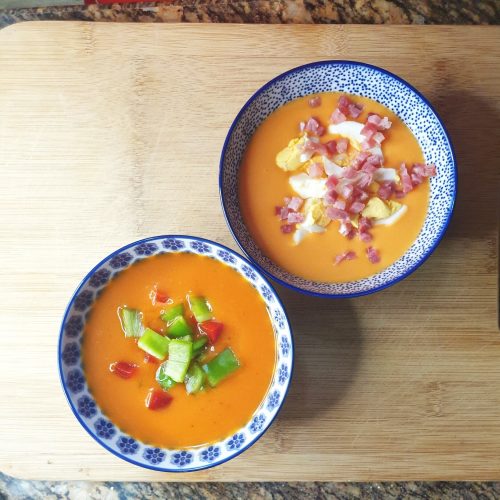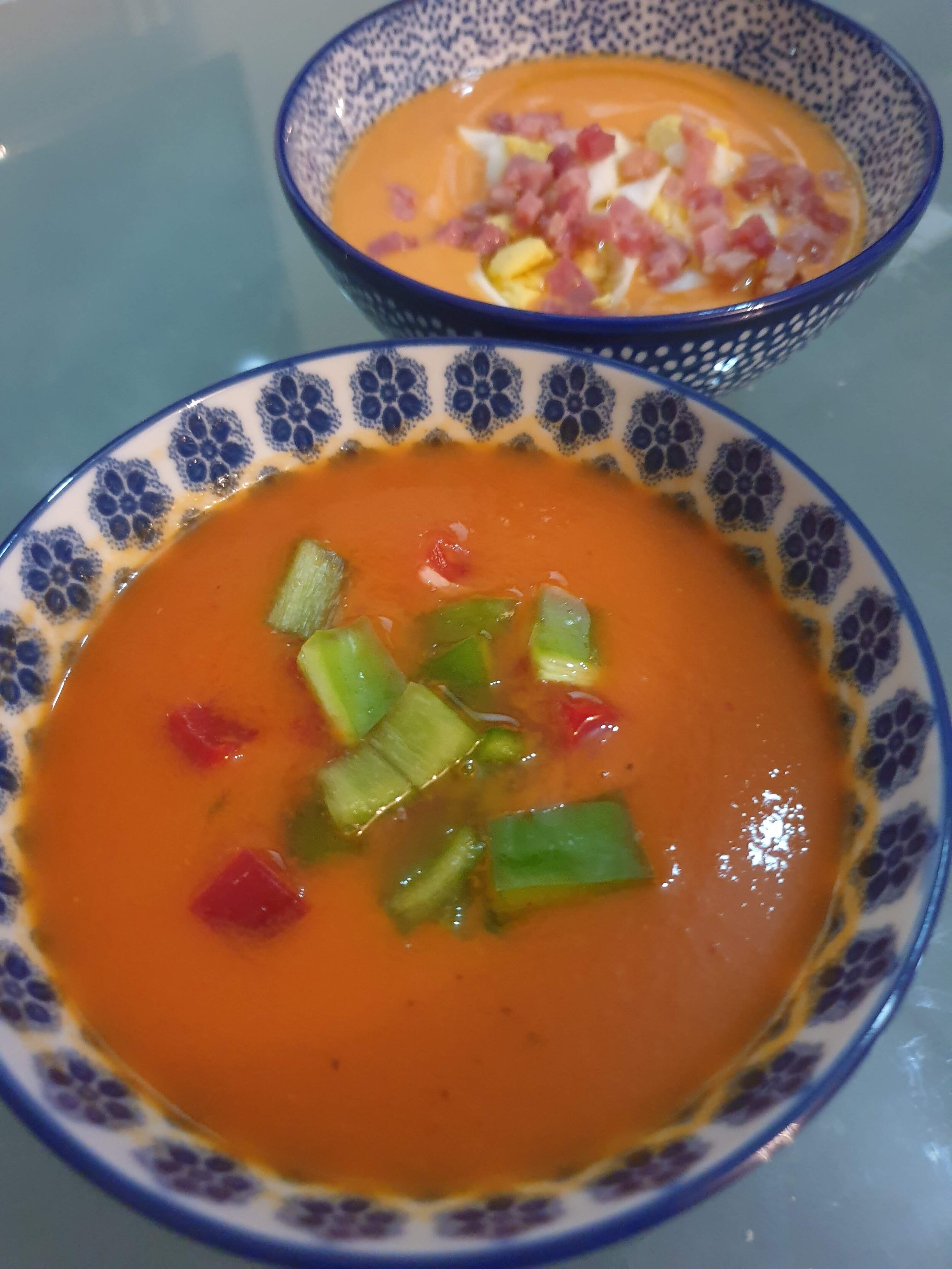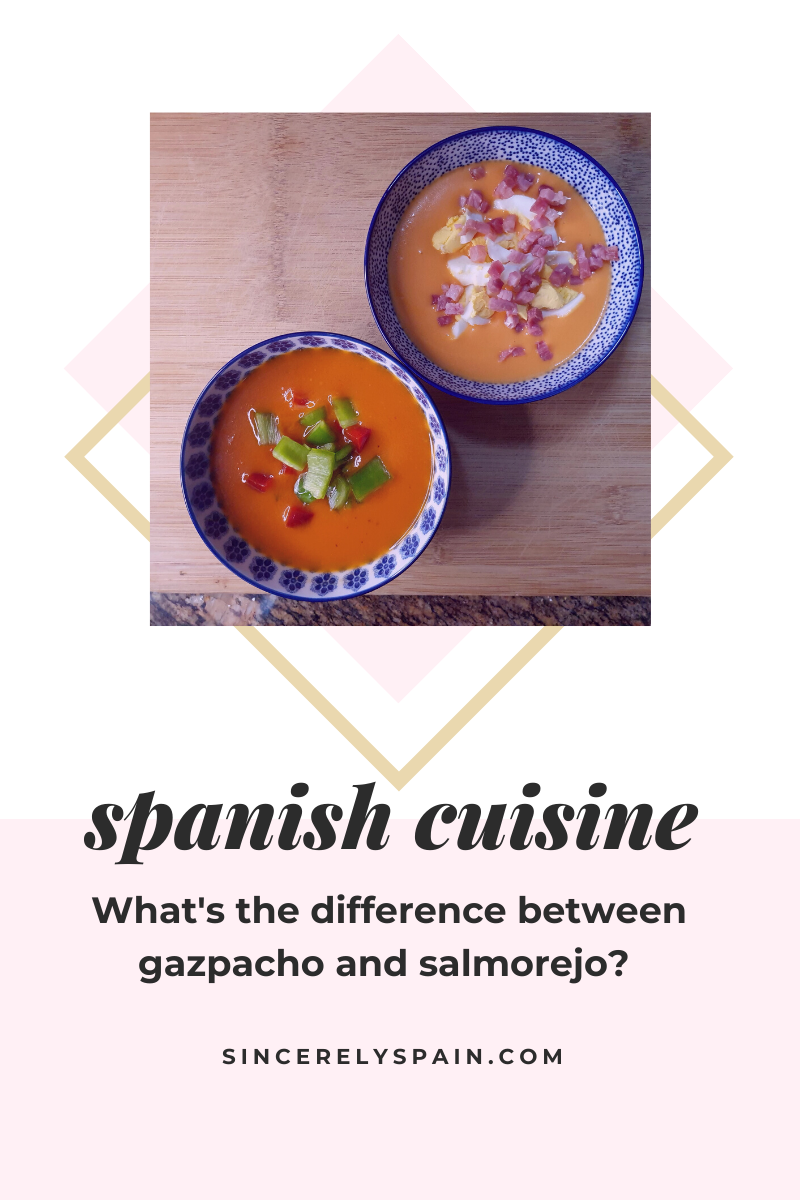
What’s the Difference Between Gazpacho and Salmorejo?

Dear Carley,
If you’ve been around here a while and read about the Mediterranean diet, how we maintain it in our own lives, our guide to a Spanish tapas-inspired snack night and/or our list of the top five Spanish foods you must try, you’ve likely heard of both salmorejo and gazpacho. You may also be aware that both are cold, tomato-based soups that are popular in Spain.
Still, if you’re new to Spanish gastronomy, it’s not uncommon if you struggle to tell them apart. If you’re wondering what the difference between gazpacho and salmorejo is or if you want to prepare them properly for yourself at home, this is the article for you!
Please note: In this article, we will be focusing on the basics of these cold soups, not sharing any of our own recipes for them. However, they are pretty ease to prepare, so we will link to one for each in case you’d like to make them from scratch.
What is gazpacho? What is salmorejo?
 Let’s begin at the beginning. While both of these dishes could be reduced to the description “cold tomato-based soup,” they are, in fact, very different. At first glance, you will notice that gazpacho is a thin, (usually) red soup whereas salmorejo is a creamier, orange soup.
Let’s begin at the beginning. While both of these dishes could be reduced to the description “cold tomato-based soup,” they are, in fact, very different. At first glance, you will notice that gazpacho is a thin, (usually) red soup whereas salmorejo is a creamier, orange soup.
Getting more specific, gazpacho is made from a base of tomato, green pepper, and cucumber whereas salmorejo is made from a base of tomato, garlic, and bread. Knowing this, you can probably already imagine how gazpacho has a very light ‘cool’ taste and consistency while salmorejo comes across as a bit denser and more filling. Even so, both are ideal soups for the hot Spanish summer!
Both of these soups can be found pre-made in any Spanish supermarket (and often at the market or frutería during hot weather as well). However, they’re not difficult to make from scratch if you have a blender or food processor. We recommend starting with Spanish Sabores’s recipe for salmorejo and gazpacho.
Why we love gazpacho and salmorejo—and you will too!
Both of these cold soups originate from Andalucía, the most southern region of Spain. Andalucía is the region we call home, so we love that it’s a local dish but, more importantly, there’s a reason gazpacho and salmorejo are so popular here—this part of the country gets incredibly hot during the summer months.
While typing this on a June afternoon in Granada, it’s 32ºC (90ºF), thankfully not too hot for us at all. 45ºC (113ºF) is common in July and August, so you can imagine how much we crave a refreshing, cool meal here during the hot season. If you could use a cool-down or simply want to immerse in an Andalusian experience from abroad, enjoying some salmorejo or gazpacho is the way to do it!
How do you garnish gazpacho?
 Because of its thinner consistency, you will find that many restaurants (and Spaniards in general) serve gazpacho in a glass. While this may seem strange after we’ve described it as a soup, the reality is that it’s not much different from a tomato juice and so many people enjoy sipping it straight from the glass.
Because of its thinner consistency, you will find that many restaurants (and Spaniards in general) serve gazpacho in a glass. While this may seem strange after we’ve described it as a soup, the reality is that it’s not much different from a tomato juice and so many people enjoy sipping it straight from the glass.
Our personal preference is to serve gazpacho in a dish* or bowl and add a few toppings. The recipe linked above gives a number of ideas for fruits and vegetables you could use to top it off, but our go-tos are simply fresh (raw) red and green peppers. This dish is vegetarian and vegan-friendly.
How do you garnish salmorejo?
Salmorejo is always served in a dish or bowl and topped with olive oil, slices of hard boiled egg, and jamón. Of course, if you are vegetarian (or preparing the soup for a vegetarian) omit the ham—the same goes for the egg if vegan. It is not traditional to top salmorejo with anything else, but you could opt for croutons or raw peppers if you’re looking to spice this soup up for a vegetarian or vegan.
When do you serve gazpacho?
Gazpacho is commonly served as a ‘first plate’ before a warm dish or simply as a tapa. When at home, though, it’s completely up to you! We enjoy making gazpacho alongside a sandwich (cold or toasted) as a full meal. While it can be served for lunch or dinner, we usually opt for lunch when the temperatures are too high to think about cooking anything warm.
When do you serve salmorejo?
Salmorejo is also commonly served as a ‘first plate’ and so you may find it as one of the primer plato options on a restaurant’s menu del día lists. Alternatively, it can be served as a smaller tapa portion or alone as a light meal. Again, at home, we generally pair this with a sandwich or salad for lunch or dinner and call it a day. When we’re in the mood for a cold meal, we’re usually not looking to get too full.
We hope this explanation answers your questions about the difference between gazpacho and salmorejo. Do you have any more doubts we could help we? Please don’t hesitate to reach out, if you do!
 Sincerely,
Sincerely,
Spain
*By ‘dish’ we are not referring to a plate, but rather a very shallow bowl that is approximately the same size as a dinner plate. These are standard dishware in Spain, but we’re not aware of a more technical way of describing them. If you’re making gazpacho or salmorejo as a main course, rather than a tapa, this is the standard dish used.




